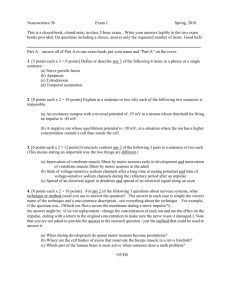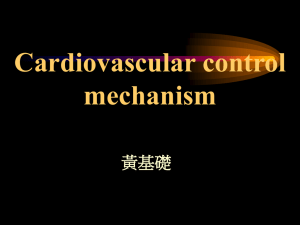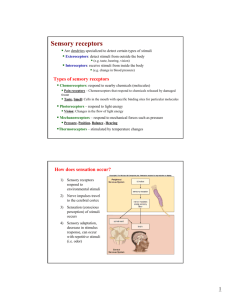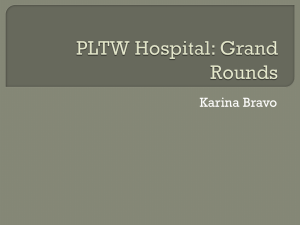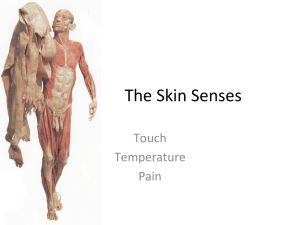2nd Sem Exam Review
advertisement
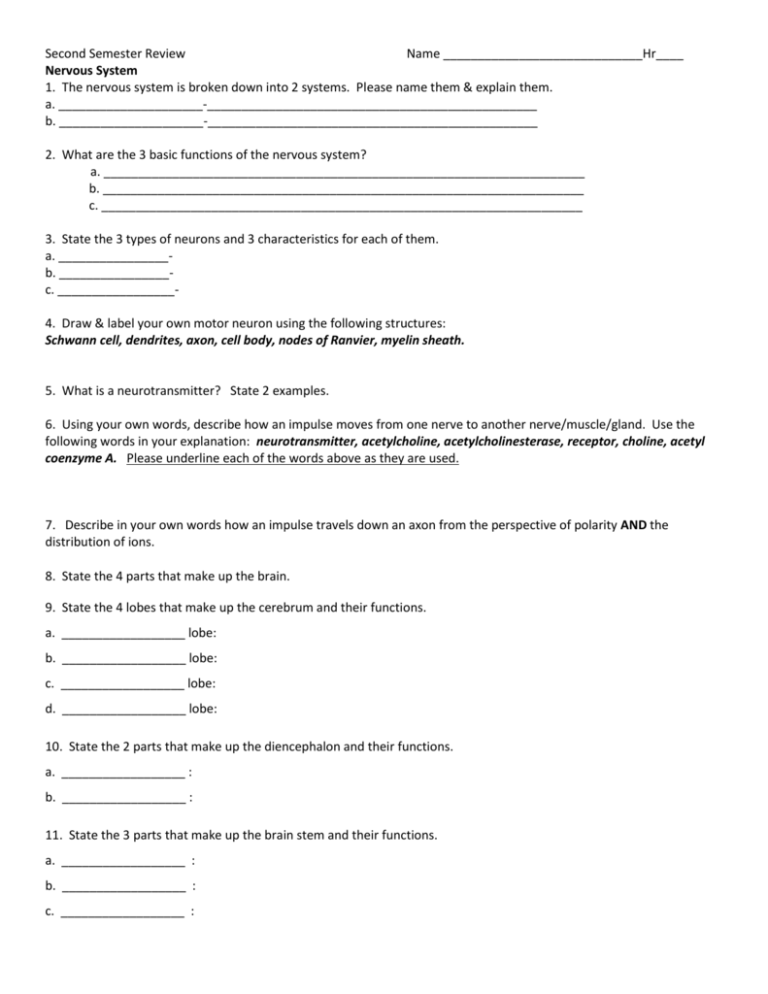
Second Semester Review Name _____________________________Hr____ Nervous System 1. The nervous system is broken down into 2 systems. Please name them & explain them. a. _____________________-________________________________________________ b. _____________________-________________________________________________ 2. What are the 3 basic functions of the nervous system? a. ______________________________________________________________________ b. ______________________________________________________________________ c. ______________________________________________________________________ 3. State the 3 types of neurons and 3 characteristics for each of them. a. ________________b. ________________c. _________________4. Draw & label your own motor neuron using the following structures: Schwann cell, dendrites, axon, cell body, nodes of Ranvier, myelin sheath. 5. What is a neurotransmitter? State 2 examples. 6. Using your own words, describe how an impulse moves from one nerve to another nerve/muscle/gland. Use the following words in your explanation: neurotransmitter, acetylcholine, acetylcholinesterase, receptor, choline, acetyl coenzyme A. Please underline each of the words above as they are used. 7. Describe in your own words how an impulse travels down an axon from the perspective of polarity AND the distribution of ions. 8. State the 4 parts that make up the brain. 9. State the 4 lobes that make up the cerebrum and their functions. a. __________________ lobe: b. __________________ lobe: c. __________________ lobe: d. __________________ lobe: 10. State the 2 parts that make up the diencephalon and their functions. a. __________________ : b. __________________ : 11. State the 3 parts that make up the brain stem and their functions. a. __________________ : b. __________________ : c. __________________ : 12. State 3 functions of the cerebellum. 13. a. How far does the spinal cord travel down the vertebral column? b. State 2 functions of the spinal cord. c. Draw a transverse cross-section of a spinal cord and label the gray and white matter. 14. Label the diagram below: 15. Compare and contrast the sympathetic and the parasympathetic nervous system. Name at least 3 differences. Auditory: 1. Label and know the function for the following structures: Pinna, auditory canal, tympanic membrane, ossicles – malleus, incus, and stapes, oval window, Eustachian tube, semicircular canals, vestibule, cochlea, vestibulocochlear nerve, vestibular nerve, cochlear nerve, organ of Corti 2. a. What 2 parts make up the outer ear? b. What 5 parts make up the middle ear? c. What 3 parts make up the inner ear? 3. In your own words, describe how a sound travels from your pinna to the temporal lobe. 4. What part of the ear detects dynamic equilibrium? ______________________________ - What is dynamic equilibrium? 5. What part of the ear detects static equilibrium? ______________________________ - What is static equilibrium? 6. What is the function of the vestibular nerve? 7. What is the function of the cochlear nerve? 8. Cranial nerve #8 is the ______________________________________________ nerve. Sensory system: 1. What are the 3 layers of the eye? 2. Label and know the function of the: cornea, choroid layer, iris, pupil, ciliary body, suspensory ligaments, aqueous humor, vitreous humor, macula lutea, fovea centralis, rods, cones, optic nerve, sclera, lens, retina 3. What are the 3 different types of cones? 4. Describe physiologically how your lens changes to look off into the distance. Describe physiologically how your lens changes to look closely at something. 5. a. Define nearsighted: b. What causes it? c. What is the solution? 6. a. Define farsighted: b. What causes it? c. What is the solution? 7. a. What causes an astigmatism b. What is the solution? 8. a. Define color blindness: b. What causes it? 9. a. Define cataracts: b. What causes it? c. What is the solution? 10. Define stereoscopic vision 11. What is the difference between general receptors and special receptors? 12. a. Pain receptors are called _________________________________. b. State locations where they can be found. 13. a. Temperature receptors are called _________________________________. b. State locations where they can be found. 14. State the 3 types of mechanoreceptors, what they detect, and where they can be found,. 1) Type: _______________________ Detect: _______________________________________ Location(s): __________________________________________________________________ 2) Type: _______________________ Detect: _______________________________________ Location(s): __________________________________________________________________ 3) Type: _______________________ Detect: _______________________________________ Location(s): __________________________________________________________________ 15. a. Receptors that detect changes in chemicals are called _________________________________. b. State 2 locations where they can be found c. State an example of these receptors at work. 16. a. Smell receptors are called ___________________________ receptors and they are found in the _________________________ cavity. b. Describe, in your own words, the how molecules of coffee in the air can send an impulse to the cerebrum . c. The olfactory nerves are cranial nerve # __________. 17. a. Taste receptors are called ___________________________ receptors and they are found in the _______. b. Specifically they are found in papillae. What are papillae? c. Describe, in your own words, how molecules of food can send an impulse to the cerebrum . 18. Draw a tongue below and label the 4 regions of taste. Blood: 1. a. Scientific name for red blood cells: _________________________ b. What is the main function of rbc’s? c. State 3 other characteristics of rbc’s: 2. a. Scientific name for white blood cells: _________________________ b. What is the main function of wbc’s? c. State 3 other characteristics of wbc’s: 3. a. Scientific name for platelets: _________________________ b. What is the main function of platelets? c. State 3 other characteristics of platelets: 4. a. Plasma is ________% water b. State 5 other substances found in plasma: 5. State 4 functions of blood: 6. Explain in your own words how nutrients from a blood vessel enter and exit a cell and enter a lymph vessel. Use the words plasma, tissue fluid, lymph, blood pressure, and osmotic pressure in your explanation. 7. Use the following terms to fill in the flow chart as it goes through the blood cutting process. thrombin fibrin prothrombin activator fibrinogen prothrombin 8. Fill in the table below: Blood Type Antigen(s) Present Antibody(s) Present 9. Explain how one would have a positive blood type versus a negative blood type. 10. Where are antibodies found in the blood? 11. What can happen to the blood if it is improperly donated? Possible Donor(s) 12. a. Explain how a mom’s blood type could eventually harm her second child. b. What do hospitals do to prevent this from happening? Cardiovascular: 1. Give 3 statements about the heart’s size & location. 2. State the 6 layers of heart tissue in order from outside to in. a. Which layer contracts to make the heart beat? _______________________________________ b. Which layer makes the pericardial fluid? ___________________________________________ 3. Describe HOW the heart is a two pump system. 4. a. What is the purpose of valves? b. Name the 2 semilunar valves c. Name the 2 atrioventricular valves. 5. Describe how the AV valves get pulled open. 6. You are the rbc. Begin in the right ventricle and label all the parts of the heart (including arteries & veins) as you go. 7. Describe the path electricity will take as it is conducted through the heart. Also, describe at what point the atriums and ventricles will contract. 8. a. Define diastole: b. Define systole: c. What is blood pressure: d. How does one determine the systole and diastole when taking someone’s B.P. 9. a. Label the EKG. b. Describe what is happening at each “wave.” 10. a. How & when does your heart make the lub sound? b. How & when does your heart make the dub sound? 11. a. Which part of the brain controls the heart rate? __________________________________ b. ___________________________ detect changes in blood pressure. c. What type of impulse slows down the heart rate? _______________________________________ d. What type of impulse speeds up the heart rate? _________________________________________ 12. Fill in the names of the proper blood vessels. Heart > ____________ > ____________ > ___________ > ___________ > ___________ > Heart 13. a. Why do veins need valves? b. Why don’t arteries need valves? c. Why do arteries have more elastic tissue than veins? d. How does blood move through your veins? e. How does blood move through your arteries? 14. Label the diagram: Lymphatic system: 1. 75% of lymph will drain into the (right / left) ___________________________ duct which will then drain into the (right / left) ________________________ (artery / vein). 2. a. The B lymphocyte is made in the _____________________________.b. What is the function of the B lymphocyte? 3. a. The T lymphocyte is made in the _____________________________.b. What is the function of the T lymphocyte? 4. a. What is the function of the lymph node? b. State 1 location in the body where there is a high concentration of lymph nodes. ______________ 5. State 1 function of the spleen. 6. What are tonsils 7. Name the three types of tonsil? 8. a. b. c. d. Where is the thymus located? _____________________________________ The hormone _______________________ is needed so that pre T-cells can become mature T-cells. Pre T-cells are found in the _____________________ of the thymus. Mature T-cells are found in the _____________________ of the thymus. 9. Give an example of a type of nonspecific defense? 10. ___________________________ are foreign invaders that stimulate the body to produce ___________________________ which “mark” the foreign invaders so that they can be destroyed by WBCs. 11. a. _____ cells are responsible for cell mediated immunity. b. _____ cells are responsible for antibody mediated immunity. 12. a. _____________________ immunity tends to be long lasting because the antibody is made by the infected individual. b. _____________________ immunity tends to be short lasting because the antibody is given to a person to fight the infection. Excretory System 1. State 3 functions of the excretory system. a. ____________________________________________________________________________________ b. ____________________________________________________________________________________ c.. ____________________________________________________________________________________ 2. Draw and label a kidney: renal artery hilus renal vein calyx renal pyramid medulla cortex 3. State 3 things that protect your kidneys: ________________ renal capsule ________________ pelvis ureter ________________ 4. State 5 substances that a nephron removes from your plasma: 5. Draw and label a nephron: Bowman’s capsule collecting duct loop of Henle distal convoluted tubule proximal convoluted tubule glomerulus 6. Fill in the blanks with the proper letter and circle the correct words as you read: a. angiotensis I b. aldosterone c. angiotensis II d. angiotensinogen e. renin When blood pressure is too low, the hormone ______ will be released. This will cause the plasma protein ______ to be converted into ______. The lungs have an enzyme which will convert that into ______. This substance will cause the veins to (constrict / dilate) and the adrenal glands to release ______. This substance will eventually cause water to (leave / enter) the blood vessels. 7. a. What is the function of aldosterone? b. Will this increase or decrease blood pressure? 8. What is the function of the ureters? 9. What is peristalsis? 10. Antidiuretic hormone: a. What releases it? _________________________________________ b. Where does water go? ________________________________________ c. What does this do to your blood pressure? ________________________________ 11. Atrial natriuretic hormone: a. What releases it? _________________________________________ b. Where does water go? ________________________________________ c. What does this do to your blood pressure? ________________________________ 12. a. What is the function of the bladder? b. What 3 points in the bladder make up the trigone? 13. What is the function of the urethra? Respiratory System: 1. Name at least 3 things that happens in each: a. External Respiration b. Internal Respiration 1. 1. 2. 2. 3. 3. 2. a. The nasal passage to the larynx is referred to as the _________________________________________ region. b. State 2 disorders that can occur in this region. _______________________ & _________________________ 3. a. The larynx to the lungs is referred to as the _______________________________________________ region. b. State 2 disorders that can occur in this region. _______________________ & _________________________ 4. The function of the nasal conchae is to __________________________________________________________. 5. What is found in each of the following regions: a. Oropharynx b. Laryngopharynx c. Nasopharynx 6. a. The left lung has _____ lobes, while the right lung has _____ lobes. b. Explain why: 7. a. Clusters of microscopic air sacs are called __________________________. b. What is their function? 8. As a red blood cell leaves the heart and approaches the lung, explain what happens to oxygen and why: When the rbc is at a cell, explain what happens to the carbon dioxide and why: 9. To be able to inhale air, explain what must happen in terms of internal pressure (and volume) of the thoracic cavity as a result of what the diaphragm and rib cage is doing. Whose law is being applied 10. Use the word bank to label the following diagram: Diaphragm Larynx Trachea Nasopharynx Oropharynx Alveoli Bronchus Laryngopharynx Bronchiole a. _________________________ b. _________________________ d c. _________________________ e d. _________________________ f a e. _________________________ f. _________________________ g g. _________________________ h. _________________________ b i. __________________________ h i c



